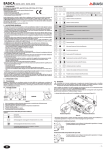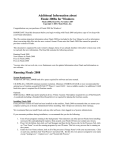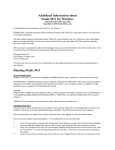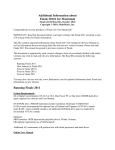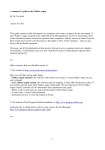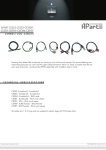Download The Harmonizer
Transcript
The Harmonizer User Manual and Theory Guide Sample Pages TM Key to Musical Symbols > = sharp, ex: G# < = flat, ex: B< ` = natural, ex: F` [ = diminished chord, ex: D[7 ] = half-diminished chord, ex: F]7 | = augmented chord, ex: A|7 dom = dominant chord, ex: Gdom7 maj = major chord, ex: Cmaj7 \ = major chord, ex: C\7 ^ = minor chord, ex: D^7 m = minor chord, ex: Dm7 C D E F G A B C D E F G A B C Caring for your Harmonizer To ensure enjoyment of your Lotus Music Harmonizer for a long time: • Keep your Harmonizer dry. • Keep your Harmonizer away from excessive heat. • Handle your Harnonizer gently. Do not use force. • Keep your Harmonizer away from dirt and dust. 30-Day Limited Warranty This product is warranted by Lotus Music against manufaturing defects in material and workmanship under normal use for thirty (30) days from the date of purchase. In the event of a product defect during the warranty period, return the product to the address below with a receipt or proof of purchase. Sender is responsible for shipping costs. Lotus Music will, at its option, repair or replace the product and deliver it at no charge (except for shipping). This warranty does not cover damage caused by liquids, heat, abuse, accident, misuse, alteration, or abnormal usage. Lotus Music, 503 Walsh St. Austin, TX 78703 Your satisfaction is important to us. Lotus Music Copyright © 2004 Lotus Music. All rights reserved. Table of Contents Introduction........................................ 5 Major & Minor Scales......................... Key Designator Names of Modes Triad Chords Fourth-Note Extensions Chord Note Extensions Scale Degrees Intervals Chord Names Parallel Minor Scale 6 6 8 9 9 10 10 12 14 18 Common Chord Substitutions......... Chord Degrees Name and Function Substitute Chord 20 21 21 23 Chord Progression Map.................... Progression Formulas Tonic Chord Harmonic Paths 26 26 27 27 Melodic Minor Scale.......................... 28 Harmonic Minor Scale....................... 30 Improvising........................................ 31 Pivot Chord Modulation.................... 32 Circle of Fifths................................... 34 Key Transposer.................................. 37 Enharmonics....................................... 39 Welcome to Lotus Music TM Lotus Music is dedicated to your musical learning and believes in making products that will enlighten you to your own musical potential. The Harmonizer is designed to make understanding the underlying structure of music easy. The Harmonizer is a great tool, but you will not become a better musician unless you practice your instrument regularly. Learning music is a wonderful journey and offers great personal rewards to those who are ready to take the first step and stick with it. The Harmonizer is a tool which will help you travel farther faster. I wish you the best on your happy, musical journey and am grateful that you have chosen Lotus Music as one of your guides. If you have any questions or comments regarding the Harmonizer, I invite you to contact our company by fax, phone or email. Tom Michero President of Lotus Music 503 Walsh St. Austin, Texas 78703 www.lotusmusic.com tel./fax: (512) 472-8989 [email protected] 4 Introduction The Harmonizer shows you important musical concepts every muscian should know. This guide will help you understand these concepts and how they are presented on the Harmonizer. This area of knowledge about musical concepts is called music theory. Understanding it allows you to make more expressive choices when composing or improvising, and provides you a language to communicate with other musicians. The Harmonizer shows you major and minor keys, the chords that belong to those keys, the notes that make up those chords, chord progressions, and much more. The Harmonizer presents music theory in a visual way which reinforces the training your ear gets when you play your instrument. It also offers many technical answers to curious musicians. The Harmonizer is appropriate for musicians of all skill levels in the same way a calculator is appropriate for math students. For the beginner, the Harmonizer offers a basic guide to scales and chords. For the more advanced musician, it is a reference tool that can help them compose and improvise. The Harmonizer consists of several sections. Each section is listed in the table of contents of this guide. Getting Started The Harmonizer design consists of clear areas called windows arranged in a pattern that displays musical information. To operate, turn the Harmonizer by holding the clear cylinder in your right hand and the black-banded end in your left. Then, twist your hands in opposite directions. You should see letters representing the scale notes appear and change in the windows of the clear cylinder. Continue to twist the Harmonizer until the letter indicating the key, chord, or note you want to know about appears in one of the appropriate windows. The Harmonizer’s layout will then reveal information you need to know for composing and improvising. This guide describes some common music theory concepts and demonstrates how to use each section of the Harmonizer. For a deeper understanding of music theory, you may elect to consult a music teacher or a textbook on the subject. The Harmonizer is designed to demonstrate musical concepts without the use of traditional musical notation, though being able to read music is certainly helpful. 5 Major & Minor Scales The most important scale used in pop, jazz, country, rock, and classical music today is a 7-note scale called the diatonic major scale. This section describes the diatonic scale and other musical concepts associated with it, including modes, chords, and intervals. The second most important scale is the natural minor scale. This scale is derived from the diatonic major scale and shares the same notes and chords. The diagram on the opposite page shows the Major and Natural Minor Scales section of the Harmonizer. The topics related to this section are indicated by number and are then described in the following pages of the guide. 1. Key Designator Major & Minor Scales When you turn the Harmonizer, you will notice different letters appear in the Key Designator window. These letters represent the names of the major keys. In modern western music the diatonic scale pattern is the basis for fifteen major keys. Each of these keys begins on a different note. The note that begins a key becomes the name of that key. The key of C major is an example of one such key. When we start playing a diatonic scale pattern beginning with C, the result is C, D, E, F, G, A, B and C. When we repeat the beginning note of the scale we have played an octave. An octave is the tonal distance between two notes with the frequency of the higher note being twice that of the lower. Diatonic Scale vs. Chromatic Scale In our western music culture there are twelve tones between each octave. This series of twelve tones is called a chromatic scale. The distance between each tone of a chromatic scale is called a half step. Two half steps make a whole step. There are, of course, six whole steps in an octave. Below is a chromatic scale beginning and ending on C. w = whole step h = half step C Chromatic scale w h h w h 6 whole steps w w w h h h h h h 12 half steps F> G> A> F G< G A< A B< B C w h D> C> C D< D E< E h h In the above example the scale begins and ends on C. If we wanted, we could repeat the sequence of tones to higher or lower octaves. The tones that make up the octave have been given letter names (A, B, C, D, etc.). Sometimes a single tone is called by two different names, i.e., C> and D<, D> and E<. 6 7 Intervals Major and Natural Minor Scales major 3rd C 2nd Dorian D E 3rd 4th D E Key Designator Major major 7th minor 3rd <7th R Ionian C 1 Chord Names 8 5th 6th F G A G A B 7th R B 9th 11th 13th D F A D m7 E G C maj7 6 Phrygian E F F G A G A Mixolydian G A B Aeolian A B C B B C E m7 D C D C D E D E E F maj7 G 7 dom A F G A m7 B F G A B m7<5 . . . G. A< B< C D E D E< F . } C C . . Mode Names 3 C E D Chord Note Extensions 5 Parallel Minor Scale } 2 G F (natural minor scale) Locrian B Scale Degrees } Lydian F C 9 4 Triad Chords Fourth-note extensions Parallel minor scale A diatonic major scale, on the other hand, consists of seven notes spaced in a specific way consisting of whole steps and half steps between them. By the way, in a system called solmization, the diatonic major scale is sung “do, re, mi, fa, so, la, ti, do.” The diatonic major scale in the key of C looks like this: C Major Diatonic Scale w w C# D# h C Db D Eb E do re w w w F# G# A# h F Gb G Ab A Bb B mi fa so la C ti do In the diatonic scale system, no matter what key is chosen, the spacing of the scale notes in steps is always: whole, whole, half, whole, whole, whole, half. The beginning note does not affect how the subsequent notes are spaced. w w h w w w h G major scale G A B C D E F> G F major scale F G A B< C D E E major scale E F> G> A B C> D> E F 7 2. Names of Modes Major & Minor Scales A mode is a new scale derived from the notes of another scale. A mode begins and ends on a note that belongs to the original scale and has all the same notes as the scale from which it is derived. The difference is simply the beginning note. Modes have names depending on what note of the original scale the mode begins on. The first mode derived from the major scale begins on the first note of the scale and is called Ionian. The Dorian mode begins on the second note, and so on. w C Ionian Mode C w h D D Dorian Mode E D E Phrygian Mode w w F G B h D C E w F w G h w A B C E F G A B C D E F G A B C E F G A B C D E F G A B C F G A B C D E F G A B C G A B C D E F G A B C B C D E F G A B C B C D E F G A B C F Lydian Mode G Mixolydian Mode Modes of the C Major scale A w w h w A Aoelian Mode A B Locrian Mode Although these modes share the same notes as the scale from which they are derived, when played they have subtly different sounds. Soloists often base their improvisations on modes, and change from one mode to another as the chords change in a song. The different tonal qualities of the modes is a function of the relative spacing of the notes from the beginning note. The diagram below shows the names of the modes of major scales, the notes they begin on, and the spacing of notes in the mode. This example shows the modes of C major. However, the spacing between notes and the mode names are the same for all the major keys. Beginning note of major scale C D Ionian 2nd Dorian 3rd Phrygian 4th Lydian 5th Mixolydian 6th Aeolian w 7th Locrian B C h D w E w E F G G G B C h w B C h w D w D E C w D D F G w G w A w A w F h F h G w E w E h F h h B C D h w w w E w B C w B C D E h w w w h w w w w A B A A A w A w w w w A w w w G h F h F h G 8 E F w 1st B w Major Scale 3. Major & Minor Scales Triad Chords Chords are created when several notes of a scale are played simultaneously. A triad chord is made up of the 1st, 3rd, and 5th note of a scale or mode. There are seven triad chords that belong to each major and minor key. Because these chords are made up only of notes from one key, they are called diatonic to that key. When you dial the Harmonizer to a particular key, you will see triad chords with their corresponding notes appear in the highlighted windows. Each chord begins with the first note of a mode. This note is called the root of the chord. The tonal distances between 1st, 3rd, and 5th notes differ according to the mode. This gives the chords their different sounds. Key Indicator Window Major and Natural Minor Scales major 3rd C Major major 7th minor 3rd <7th R 2nd Ionian C D Dorian D E Phrygian E Lydian F F G 3rd 4th 5th 6th F G A F G A B G A B E A B C C Highlighted notes indicate a triad chord. 4. Fourth-Note Extensions D 7th R 9th 11th D F C D m7 E G D E m7 B E C F maj7 maj7 G Adding these notes to a triad produces a chord called a 7th chord. Major & Minor Scales A fourth note can be added to a triad to give it a more interesting sound. Often, this fourth note of the chord is the seventh note of the scale or mode. Chords that have this seventh note included are called seventh chords. Seventh chords are written like this: Cmaj7, Dm7, G7 (Gdom7). Sometimes, the sixth note of the scale will be added instead of the seventh. As you might guess, this chord is called a sixth chord, i.e., C6, Fm6. 9 Chord Progression Map The number of ways chords can go together to produce new and interesting sounds is nearly infinite. Musicians use their intuition and experience to arrange chords in ways that move the music along. This notion of movement is important to understanding how to compose and improvise a piece of music. The Chord Progression Map shows some often-used progressions which create harmonic movement. Harmonic Movement Usually the interplay between chords in a piece of music creates the feeling of movement and change. Some chord combinations sound uplifting, others sound somber, and some sound like ocean waves. While these harmonies and how we interpret them are nearly endless, there is a very simple principle at work. Most pieces of music tend to first establish a feeling of stability, depart from it, create tension, then return to the feeling of stability. Though some pieces of music demonstrate this more dramatically than others, as you train your ear you will become increasingly aware of it. 2 Tonic Chord Chord Progression Map Set Indicator 1 1. IIm II[ D IV F IVm V G Vm E IIIm { 4 Major <VI A< I - IV - V I - IIm - V I - VIm - IIm - V I - IIIm - VIm - IIm - V I VIm Minor A C Im - IVm - Vm (natural) VI[ Im Im - II[ - V (harmonic) Im - VI[- IIm - V (melodic) Im - <VI - IVm - V (harmonic) Progression Formulas Progression Formulas 3 Harmonic Paths Chord Progression Map The way chords are placed one after the other in a piece of music is called a chord progression. The Roman numerals indicating chord degree are used to designate the chords in a progression. For example, in the key of C major a I, IV, V7 (one, four, five) progression indicates the chords Cmaj, Fmaj, and Gdom7. In the key of F these chords would be Fmaj, B<maj, and Cdom7. This section of the Harmonizer shows the formulas of the more common chord progressions in major and minor keys. All of the major progression formulas presented here are based on the major scale. However, the minor progressions are based on the minor scale indicated within parentheses. 26 Harmonic Minor Scale The harmonic minor scale is another variation of the natural minor scale. By raising the seventh note of the natural minor to a major seventh interval, this scale resolves to the tonic with more movement. However, this leaves a minor third interval between the sixth and seventh note. This openness gives the scale an exotic character. This scale is sometime called the snake-charmer scale. Harmonic Minor Scale Harmonic Min. Im When this window is dark the displayed notes are enharmonically correct. (See page 39 for details.) 2nd C F G A< B C B B B B C G A< B 7th R 6th G A< G A< B (13th) 5th F F F Phrygian`3 V G A< Lydian >2 A< <VI Alt <<7 VII[ 3rd 4th D E< Locrian `6 II[ D E< Ionian>5 E< <III Dorian >4 IVm (11th) (9th) R C C C F F m7 G dom7<9 F F G A< maj7 G A< B dim7 D E< D E< m(maj7) D m7<5 D E< maj7>5 D E< D E< C C The Layout This harmonic minor section of the Harmonizer is presented similarly to the melodic minor. If you are not already familiar with the layout, please refer to the melodic minor section of this guide (see page 28). The modes of the harmonic minor scale produce some interesting-sounding chords which can add originality to a piece of music. Below is a comparison of the harmonic minor scale to the natural minor. w C Natural Minor w w h w w C D E< F G A< B< C 1 2 <3 4 5 <7 8 w h w w <6 h w+h h C D E< F G A< B C 1 2 <3 4 5 7 8 <6 { C Harmonic Minor h 30 minor 3rd Improvising Improvising is one of the great creative outlets available to musicians. Often a musician will improvise a solo while another plays chords. The soloist chooses notes to play over the chords based on intuition, experience, and a few simple rules. Playing Arpeggios Over Chords A simple way to improvise is to play individual notes of a chord while the chord is sounding during a song. For instance, when a measure has Cmaj7 in it, you could play a riff of individual notes made up of C, E, G, B. As long as you stick to these notes while the chord is playing, your improvising will harmonize with the song. Major Scale C E F G B C A D Cmaj7 Playing Scales and Modes Over Chords Another way to improvise is to play individual notes of the scale or mode on which the chord is based. For instance, since Dm7 is based on the Dorian mode, you could play riffs using any notes from that mode. Dorian Mode D E F G A B C D Dm7 Playing Over Dominant and Altered Chords Sometimes it is appropriate to play scales or modes that are slightly different from the scale or mode the chord is based on. By doing this, you introduce notes that alter the harmony, usually making it more dissonant. Because altered chords usually sound dissonate, they often make good dominant chords. The example below shows the notes of G myxolydian against the Gdom7 chord. Just below that is the G phrygian `3 mode (from the harmonic minor scale). Playing this mode over a Gdom7 will make it sound like a Gdom7<9 by adding the flatted 9 to the harmony. G Myxolydian G G Phyrgian `3. G A< A B C D B C D E< E Gdom7 F G F G A< Gdom7<9 <9 <9 Below is a table of chords with suggested scales and modes appearing on the Harmonizer that can be played over them. The root of the chord becomes the beginning note of the scale or mode. Ex: Play G myxolydian over a Gdom7 (G7) chord. Dom7 Min6 Dom7<9 Dim7 Min7<5 Maj7 Type of Chord Min7 Suggested scale or mode for playing over chord. Ionian Lydian Dorian Aeolian Phrygian Harmonic Minor Melodic Minor Locrian Locrian `6 Locrian `2 Myxolydian Super Locrian Phrygian `3 Blues Scale Alt <<7 Locrian 31 The Turnaround The IIm-V7 (often called two-five) combination of chords is called a turnaround and is frequently used in jazz. Any two consecutive roots on the wheel moving counter-clockwise produce a IIm-V7 turnaround combination. The combination is often played the end of a musical phrase because it “turns around” the chord progression and starts it over again. A turnaround usually leads to the tonic chord. In the key of C major, the turnaround would be Dm (IIm), Gdom7 (V7), C (I). You will notice that if we begin on the D on the outer ring of the circle and move counter-clockwise, we encounter the G and the C in the same order as played to create a turnaround. Rotating counter-clockwise shows the roots for a IIm-V7-I turnaround. Ex: In the key of F that looks like: Gm, C7, F I V7 C F G IIm D A E D B< G B Circle E< C of 5ths F> A VIm IV Up a 5th or Down a 4th A> D> G> C> E B< E< A< IIIm D< C< G< C> B A< F Down a 5th or Up a 4th F> Finding the Tonal Center Another use for the wheel is analyzing tonal centers of a piece of music. Often a piece of music will change keys. (You can’t always tell the tonal center just by looking at the key signature.) However, since the presence of a dominant chord often determines the tonal center, the wheel can suggest a possible center. To find the center, identify the root of the dominant chord on the outer ring and move along counter-clockwise one note. This note will probably be the center. For instance, if a Ddom7 appears in a piece of music, find the D, then move counter-clockwise one note. The result is G, the tonal center. 36 What does the Harmonizer do? The Harmonizer helps new and seasoned musicians learn and apply music theory principles to composing and improvising. The Harmonizer’s patented design shows musical concepts in a visual format, making learning easy and fun. The Harmonizer works for any instrument. The Harmonizer aids musicians with: scales & modes chord construction chord progression chord substitution intervals modulation transposition The Harmonizer is perfect for any musician who wishes to deepen their understanding of music theory and enhance their playing ability. Its easy-to-use format works like a slide-rule. Simply dial the Harmonizer to any key and view all the information about that key instantly. Lotus Music Copyright © 2004 Lotus Music. All rights reserved.














